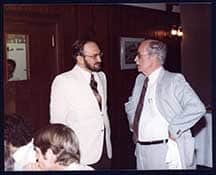Welcoming Chemtura’s recent moves to increase the rate at which it can treat contaminated groundwater, Elmira’s environmental watchdog group says the company should be doing more.
Unless the chemical producer moves past treatment to removing the underground pollutants, the 2028 timeline for restoring the aquifers to drinking water standards is in jeopardy, says the chair of the Chemtura Public Advisory Committee (CPAC).
“There continue to be many areas of concern regarding the remediation. The efforts to reclaim the clean water of the Elmira aquifers have continued now for over 25 years, and they will probably continue for another 25 years or more,” Dan Holt told Woolwich councillors meeting June 2.
Holt said CPAC is not optimistic the company’s longstanding plan to remediate the aquifers by pumping up water, treating it and then discharging it into the Canagagigue Creek will be adequate.
Chemtura – Uniroyal Chemical at the time, then later Crompton Co. – has been using a pump-and-treat process to remove a pair of toxins – NDMA (nitrosodimethylamine) and chlorobenzene – from the former drinking water aquifers underneath Elmira. Discovery in 1989 of the carcinogenic NDMA precipitated the water crisis in Elmira, leading to the construction of a pipeline from Waterloo, which supplies the town with water to this day.
An MOE control order sets out the company’s responsibility for dealing with the contaminants in the municipal aquifers, with a deadline of 2028.
Holt and CPAC have argued that the contaminants can last for hundreds of years, bringing into doubt that left in the ground they’d suddenly stop polluting the aquifers. In 2012, the group won the support of council for a resolution asking the Ministry of the Environment to take steps to ensure the deadline would be met.
This week, Holt cited a pair of letters that recently came to the committee’s attention. Both recommend the removal of the source contaminants, not just treatment.
Holt quoted from a letter dated May 2, 2008 a Ministry of the Environment hydrogeologist who raised concerns about the efficacy of the pump-and-treat program.
“In my opinion, long-term reliance on hydraulic containment carries with it substantial risks. Reduction in source concentration is a desirable objective and is consistent with the multi-barrier approach to dealing with contaminant threats,” wrote Jamie Connelly.
Likewise, a letter written two weeks later by an independent hydrogeologist, Wilf Ruland, followed that thread.
“I would like Chemtura to make a firm commitment … toward a goal of working toward progressively improving groundwater quality throughout the Chemtura property. The implication of such a commitment would be that in places where there is good evidence suggesting the possible presence of [contaminants], active measures would be undertaken to remove or neutralize these contaminant sources as soon as reasonably feasible.”
Both letters support CPAC’s assertions the pump-and-treat measures, even with plans to double and triple the rate of extraction, are likely to be inadequate, he stressed.
The committee is also concerned about MOE plans to test levels of DDT and dioxins, the result of high readings discovered in 2012. The ministry wants to know if the readings were anomalies, as previous tests had not shown that to be the case. Holt, however, said CPAC is worried about how long it will take to get the results – 18 months – and that the province has indicated it has no plans to take action if there are in fact high levels of those toxins.
“There is no plan of action. We’ll just have a report that they are high,” he said.
Coun. Mark Bauman, noting the first step is to do the testing, suggested that if the results come back with high levels, the township will have to press the company and the ministry for answers.
Next Article
Reflecting on EDSS’s 75 years








